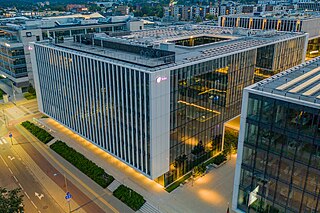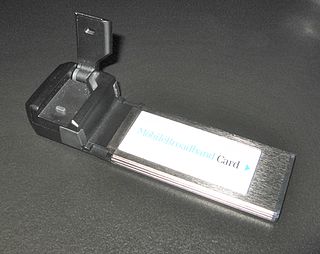
General Packet Radio Service (GPRS), also called 2.5G, is a packet orientated mobile data standard on the 2G cellular communication network's global system for mobile communications (GSM). GPRS was established by European Telecommunications Standards Institute (ETSI) in response to the earlier CDPD and i-mode packet-switched cellular technologies. It is now maintained by the 3rd Generation Partnership Project (3GPP).
In telecommunication, a public land mobile network (PLMN) is a combination of wireless communication services offered by a specific operator in a specific country. A PLMN typically consists of several cellular technologies like GSM/2G, UMTS/3G, LTE/4G, NR/5G, offered by a single operator within a given country, often referred to as a cellular network.

3G is the third generation of wireless mobile telecommunications technology. It is the upgrade to 2G, 2.5G, GPRS and 2.75G Enhanced Data Rates for GSM Evolution networks, offering faster data transfer, and better voice quality. This network was superseded by 4G, and later by 5G. This network is based on a set of standards used for mobile devices and mobile telecommunications services and networks that comply with the International Mobile Telecommunications-2000 (IMT-2000) specifications set by the International Telecommunication Union. 3G is used in wireless voice telephony, mobile Internet access, fixed wireless Internet access, video calls and mobile TV.

The 3rd Generation Partnership Project (3GPP) is an umbrella term for a number of standards organizations which develop protocols for mobile telecommunications. Its best known work is the development and maintenance of:
4G is the fourth generation of broadband cellular network technology, succeeding 3G and preceding 5G. A 4G system must provide capabilities defined by ITU in IMT Advanced. Potential and current applications include amended mobile web access, IP telephony, gaming services, high-definition mobile TV, video conferencing, and 3D television.
The GPRS core network is the central part of the general packet radio service (GPRS) which allows 2G, 3G and WCDMA mobile networks to transmit Internet Protocol (IP) packets to external networks such as the Internet. The GPRS system is an integrated part of the GSM network switching subsystem.

M1 Limited is a Singaporean telecommunications company and one of the major telcos operating in the country. M1 was founded in 1994 and traded on the Singapore Exchange from 2002 to 2019. M1 is a subsidiary of the Keppel Corporation and Singapore Press Holdings through their joint venture, Konnectivity.

Radio Móvil Dipsa S.A.U., doing business as Telcel, is a Mexican wireless telecommunications company, owned by América Móvil, founded in 1984 and based in Mexico City. Telcel holds concessions to operate a wireless network in all nine geographic regions in Mexico using both the 850 megahertz and 1900 megahertz radio spectrum.
Multimedia Broadcast Multicast Services (MBMS) is a point-to-multipoint interface specification for existing 3GPP cellular networks, which is designed to provide efficient delivery of broadcast and multicast services, both within a cell as well as within the core network. For broadcast transmission across multiple cells, it defines transmission via single-frequency network configurations. The specification is referred to as Evolved Multimedia Broadcast Multicast Services (eMBMS) when transmissions are delivered through an LTE network. eMBMS is also known as LTE Broadcast.

Telia Lietuva, a member of Telia Company group, is one of the largest telecommunication companies in the Baltic States.

Sri Lanka Telecom PLC, doing business as SLT-MOBITEL, is the national telecommunications services provider in Sri Lanka and one of the country's largest companies with an annual turnover in excess of Rs 40 billion. The company provides domestic and corporate services which include fixed and wireless telephony, Internet access and IT services to domestic, public and business sector customers. As of 2018 SLT-MOBITEL was Sri Lanka's second largest mobile network operator with over 7.9 million subscribers.
A wide variety of different wireless data technologies exist, some in direct competition with one another, others designed for specific applications. Wireless technologies can be evaluated by a variety of different metrics of which some are described in this entry.

Mobile broadband is the marketing term for wireless Internet access via mobile networks. Access to the network can be made through a portable modem, wireless modem, or a tablet/smartphone or other mobile device. The first wireless Internet access became available in 1991 as part of the second generation (2G) of mobile phone technology. Higher speeds became available in 2001 and 2006 as part of the third (3G) and fourth (4G) generations. In 2011, 90% of the world's population lived in areas with 2G coverage, while 45% lived in areas with 2G and 3G coverage. Mobile broadband uses the spectrum of 225 MHz to 3700 MHz.
Proxy Mobile IPv6 is a network-based mobility management protocol standardized by IETF and is specified in RFC 5213. It is a protocol for building a common and access technology independent of mobile core networks, accommodating various access technologies such as WiMAX, 3GPP, 3GPP2 and WLAN based access architectures. Proxy Mobile IPv6 is the only network-based mobility management protocol standardized by IETF.
In telecommunications, long-term evolution (LTE) is a standard for wireless broadband communication for mobile devices and data terminals, based on the GSM/EDGE and UMTS/HSPA standards. It improves on those standards' capacity and speed by using a different radio interface and core network improvements. LTE is the upgrade path for carriers with both GSM/UMTS networks and CDMA2000 networks. Because LTE frequencies and bands differ from country to country, only multi-band phones can use LTE in all countries where it is supported.
International Mobile Telecommunications-Advanced are the requirements issued by the ITU Radiocommunication Sector (ITU-R) of the International Telecommunication Union (ITU) in 2008 for what is marketed as 4G mobile phone and Internet access service.

MagtiCom, Ltd. is a Georgian telecoms company founded on February 12, 1996 by Dr. George (Gia) Jokhtaberidze. On September 22, 1997, the Company made the first commercial call from its mobile network. The services offered by MagtiCom involve as follows: mobile telephony; mobile internet ; Cable fixed telephony (VoIP); internet television (IPTV) and fiber-optic internet. Since 2016 MagtiCom started to provide IPTV, VoIP and fiber-optic internet.

A mobile broadband modem, also known as wireless modem or cellular modem, is a type of modem that allows a personal computer or a router to receive wireless Internet access via a mobile broadband connection instead of using telephone or cable television lines. A mobile Internet user can connect using a wireless modem to a wireless Internet Service Provider (ISP) to get Internet access.
Packet Forwarding Control Protocol (PFCP) is a 3GPP protocol used on the Sx/N4 interface between the control plane and the user plane function, specified in TS 29.244. It is one of the main protocols introduced in the 5G Next Generation Mobile Core Network, but also used in the 4G/LTE EPC to implement the Control and User Plane Separation (CUPS). PFCP and the associated interfaces seek to formalize the interactions between different types of functional elements used in the Mobile Core Networks as deployed by most operators providing 4G, as well as 5G, services to mobile subscribers. These two types of components are:
- The Control Plane (CP) functional elements, handling mostly signaling procedures
- The User-data Plane (UP) functional elements, handling mostly packet forwarding, based on rules set by the CP elements.










